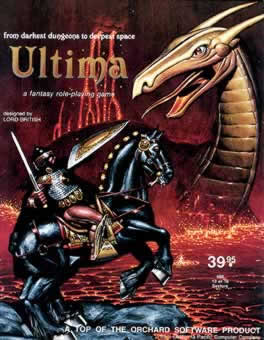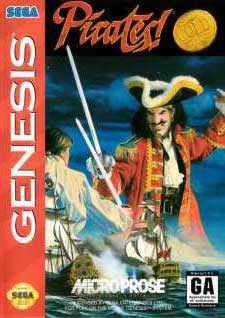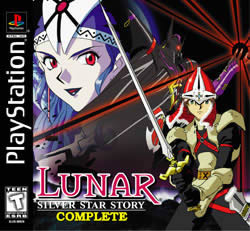Genesis fans the world over have played games by Tim Trzepacz. Whether it’s the rare and valuable Pirates! Gold, or the Sega CD classics Lunar 1 & 2, you’ve probably seen his handiwork somewhere. Having done stints at both Microprose and Working Designs, he’s seen a lot of what goes into the technical aspects of actually making a game.
 A regular in the industry for almost two decades, Tim has worked on his fair share of computers and consoles. He’s dealt with many properties that have gone on to become true classics, like Pirates! Gold for the Genesis, Dragon Force on the Saturn, and both Lunar games on the Playstation. After some time at Insomniac games, where he played an integral part in the Ratchet & Clank series, he decided to head out on his own. Tim is currently the head of SoftEgg Enterprises, a full-featured programming and creative services company.
A regular in the industry for almost two decades, Tim has worked on his fair share of computers and consoles. He’s dealt with many properties that have gone on to become true classics, like Pirates! Gold for the Genesis, Dragon Force on the Saturn, and both Lunar games on the Playstation. After some time at Insomniac games, where he played an integral part in the Ratchet & Clank series, he decided to head out on his own. Tim is currently the head of SoftEgg Enterprises, a full-featured programming and creative services company.
Recently, Sega-16 had a chance to chat with Tim about his experiences with the Genesis.
Sega-16: How exactly did you get involved in gaming?
Tim Trzepacz: There were a lot of moments throughout my life. I suppose my earliest awareness of computer games was when my mother brought home a Texas Instruments Silent-700 terminal from her office…the kind with an acoustic coupler that you stuck the phone into. It printed all I/O on thermal roll paper.
We used it to play the Colossal Cave Adventure by Crowther and Woods. In that game you basically wandered around in and around a big, treasure filled cave and tried to solve puzzles to find treasures by typing two word commands like “go north” or “kill dragon.” I was completely captivated! I never did finish the game, but I played it a lot. I think I must have been 7 or 8 years old at the time. Afterwards you could take the rolled up paper of everything that happened to you during the game, stretch it out and play light sabres!
I soon got the Atari 2600, and was once again captivated by a game called Adventure…this time by Warren Robinette. It’s iconic representation of castles, bats, dragons and keys really struck a chord with me. I loved how the little world had it’s own rules… the magnet could get the key out of walls, the bridge could let you cross into screens that didn’t quite exist… I’ve always loved exploration and experimentation.
Finally, in the arcade, a third game called Venture also captivated my imagination. In that game you took a little smiley face with a bow and arrow against traps and treasures in a minimalist dungeon setting.
In middle school, some friends introduced me to Dungeons and Dragons…the paper game. I ended up reading more rule books and modules than actually playing them. About that time, the first TRS-80 computers started to show up, and I desperately wanted to have my own computer! I did anything I could to gain access to the computer at my middle school to play with basic programming… we didn’t even have any games!
Finally, in seventh grade, my dream came true! Our house burned down (!) and my parents got me an Atari 800 with part of the settlement money. Since I didn’t even have a cassette drive, I had to write my own games! I wrote tons of half-finished epics in BASIC on the Atari. Later I moved to the Atari ST where I wrote a bunch of stuff in Pascal and C, including a point-and-click based text adventure, and a couple of homebrew MIDI sequencers.
At that point, a bunch of friends and myself started working pretty seriously on trying to make our own games. We’d have parties called “Hackathons” where we’d stay up all night and try to write a game. I usually ended up doing more art and sound than programming at that point.
Our group was pretty high caliber for a bunch of high-school kids. David Baggett was definitely the best programmer among us, he later went on to work on Crash Bandicoot 1 & 2 for Naughty Dog, before leaving the game industry entirely. He wrote this system for the ST called Game Workbench that was probably the first commercial game engine… but at the time conventional wisdom was that all games were home-rolled assembly and it never got the distribution it deserved. I helped spec out the sprite animation tool (being that I was usually the animator on our stuff) and he made Animatic… which was years ahead of it’s time. It kicked Deluxe Paint‘s ass!
David Leary was more of a game design guy… he was really good at coming up with designs for levels and funny things to do in games. He now works at Ensemble Studios on games in the Age of whatever series. Bruce Davis was a programmer with a real “gung-ho” attitude and a lot of fire and energy. He was our group’s lone C64 guy. I think he works for Microsoft in some non-game capacity now… I haven’t heard from him in years. Chris Nebel was (is still) a real Apple believer, although he didn’t even own his own computer until college! Between him and myself we were responsible for most of the art in our creations. He now works for Apple on Applescript. Bryan Buck was (is still) an amazing programmer and an incredible fan of science fiction and comic books. He was kinda on the outskirts of our initial programming group, but is still a great friend of us all. He just finished his Ph.D and now works for Symantec.
 We tried to sell Electronic Arts on letting us write them an Atari ST version of Archon… we went and drew all the art and had sprites moving and stuff and then called them up, only to be told that they didn’t think that the ST was a viable platform. Despite that, we kept messing with the ST for almost 10 years! I wrote a bunch of unreleased stuff including a two player 3D dungeon combat game called Dungeon Duel and a 2D shooter called Double Barrel. We had big plans for the ultimate role-playing game, a game called Erebos that was to be a kind of cross between Ultima and Archon. It would have big maps like Ultima, only fine scrolling with a huge algorithmically-generated world, but all combat would be arcade-style like Archon. There was a whole plan for a spell system that was based on spell components and “magic physics” that was very similar to what Dungeon Master and Ultima Underworld eventually came up with.
We tried to sell Electronic Arts on letting us write them an Atari ST version of Archon… we went and drew all the art and had sprites moving and stuff and then called them up, only to be told that they didn’t think that the ST was a viable platform. Despite that, we kept messing with the ST for almost 10 years! I wrote a bunch of unreleased stuff including a two player 3D dungeon combat game called Dungeon Duel and a 2D shooter called Double Barrel. We had big plans for the ultimate role-playing game, a game called Erebos that was to be a kind of cross between Ultima and Archon. It would have big maps like Ultima, only fine scrolling with a huge algorithmically-generated world, but all combat would be arcade-style like Archon. There was a whole plan for a spell system that was based on spell components and “magic physics” that was very similar to what Dungeon Master and Ultima Underworld eventually came up with.
We planned and planned, but nothing ever came of our big game idea. We eventually split up and went off to college in separate places, but somehow kept getting together when we came home from school. Eventually most of the crew ended up going to University of Maryland, while I actually slugged out an Electrical Engineering degree at Virginia Tech (where I co-founded the anime club, VTAS). After college, I tried a job in EE and hated it, so I ended up applying to Microprose at the urging of my old college friend Scott Elson (who worked on B.O.T.T.S. for their arcade division.) I ended up working with Joe Hellesen in their console games division on the Sega Genesis version of Pirates! Gold. I loved programming on the Sega Genesis…it was like the Atari 800 and the Atari ST all rolled into one! Unfortunately, $20 each on 50k carts was too hugh a manufacturing cost for Microprose to stomach and they soon got out of the console business. I ended up working on the ill-fated MS-DOS version of Magic: The Gathering, where I brought on David Leary as a design consultant.
Sega-16: Were there any projects you would like to have worked on for the Genesis but never got the chance to do?
Tim Trzepacz: I still have a 28-page design I made for a four-player, split screen, competitive action RPG that I went so far as to start writing a prototype for before Microprose dissolved console completely. We were also in pre-production of a game called Dynatack for Genesis which would have been an action version of the old Epyx game Crush, Crumble, and Chomp. Our artist on Pirates!, Mike Bazzel, was one of the best game artists I had ever seen and he had done some amazing dinosaur art for that game…it would have kicked ass!
There was a bunch of stuff what WAS completely developed but never saw the light of day, including a Genesis version of Ancient Art of War in the Skies, and both SNES and Genesis versions of a remake of Impossible Mission licensed from Epyx that included the entire original C64 game as well as the remade version that kinda stank. Also, a platform game called Pinhead from the UK that was really kinda fun. I think Ballistic eventually released it in the waning days of the Genesis.
Sega-16: Exactly how big a part did you have in the production of Pirates! Gold?
Tim Trzepacz: I wrote a complete animation engine for the Sega Genesis called SAGA that ran on a dual-monitor PC (one monochrome, and one color) and was used to implement all the animations in the game. Originally, it was intended that an artist (Mike, I guess) would use the system to animate all of their stuff, but in the end I ended up using the system to do all the animations myself. It would have been easier to just code them all in C by hand, but they asked for a system and I delivered! As the creator of the animation system, I ended up implementing everything that used it, including the towns, all incidental screens, the in-ship menus, the trading interface, the logbook, etc.
I also wrote the fencing system, which was a big change from the original Commodore version we started with. Originally our lead programmer, Joe Hellesen was working on it, but he left halfway through the project to move back to Chicago. After he left, I ended up touching many of the game’s internal systems, from sailing to the world map. I fought with the other remaining programmer on the project, Eric Repasy endlessly about everything. I was young and stupid.
Sega-16: The game is a fan favorite, and goes for quite a bit of money on eBay.
Tim Trzepacz: It does? I guess that’s probably because they only printed 50,000 copies and sold every last one of them. We were released at the same time as F-15 Strike Eagle for Genesis. When we got the returns back from Wal-Mart, there were hundreds of F-15s, but only about twenty of Pirates, so I guess people must of liked it. I took the returned copies that worked and distributed them to the rest of the remaining team.
Sega-16: Did you ever think it would be as widely accepted as it has?
Tim Trzepacz: Was it really widely accepted? I haven’t really gotten any mail about it until now! I remember hand-carrying it out to Gamefan magazine on my vacation and they wouldn’t even review it. They later did a very nice piece on it in their “Graveyard” section after the Genesis was dead…
Sega-16: What do you think of the remake (Xbox, PC)?
 Tim Trzepacz: Well, Pirates! Gold for PC was a completely separate project from ours… it was pretty much all run by a certain artist at the company who made really pretty art but had no sense of game design. I later ripped off a lot of the assembly code for drawing to use on Magic. I’ve never heard of a remake on X-Box? I guess I’m not surprised that they would do a remake of a great game like that… I’m just surprised that it took them so long.
Tim Trzepacz: Well, Pirates! Gold for PC was a completely separate project from ours… it was pretty much all run by a certain artist at the company who made really pretty art but had no sense of game design. I later ripped off a lot of the assembly code for drawing to use on Magic. I’ve never heard of a remake on X-Box? I guess I’m not surprised that they would do a remake of a great game like that… I’m just surprised that it took them so long.
Sega-16: You worked on several Genesis products at Microprose that never saw the light of day (Dynatack & Top Gun). Could you tell us a bit about these games and how far they were along when they were cancelled?
Tim Trzepacz: Dynatack had a lot of production art and gameplay screen mockups. Did I mention that Mike Bazzel is the most amazing pixel artist ever? As we were starting a new project, I had done a LOT of work shoring up the underpinnings of our Sega Genesis code. I came up with a much faster way to build our art files into the binary by generating COFF files that were directly linkable into our source, and had rewritten a bunch of our low-level assembly stuff to allow all the Genesis registers to be shadowed into RAM to simplify the code and allow for neat color effects with interrupts. I actually disassembled Sonic the Hedgehog to see how they did horizontal blank interrupts, but there was never any gameplay running for Dynatack.
Top Gun was a strange idea for a game. The idea was to make a jet-combat game where you could execute special moves like in Street Fighter to make your plane to loops or immelmans, or whatever. I think we were going to make it for Sega CD. I wrote a little prototype with a plane from the SNES version of F-15 on a scrolling background with a shadow for height that could scroll in any direction and shoot bullets out the front. Nobody was impressed.
At that point, all of the remaining console programmers were supposed to be working on this, but nobody but me was taking it seriously. All the SNES guys didn’t want to mess on the Genesis, and nobody was really running the ship in console. So I just stopped working on it and started working on Blakhart. Nobody seemed to care, and I thought if I could just get a good demo together before they assigned me to something else, I might have a chance of getting them to green-light it. Alas, the entire console division was dissolved, and neither saw the light of day.
Sega-16: There’s a growing homebrew community for retro consoles like the Genesis. Any chance these games might yet see a release? Who has the prototypes?
Tim Trzepacz: There wasn’t enough of a prototype of those two games to really call a game. Top Gun was a simple scrolling demo, and Dynatack was a bunch of still screens and sprites. Blakhart had a four-player, split-screen demo using the EA multi-tap (I reverse engineered the access code from General Chaos) where you could walk a little guy around. I used art me and my friends had made for our Archon clone back in the ’80s for testing! Still, not quite to the point of having any gameplay.
Sega-16: During your time at Working Designs, you worked on both Lunar remakes. Exactly how much had to be added to them, that had been cut from the Sega CD originals?
Tim Trzepacz: You have to understand that what Working Designs does is only localization. They don’t really have any ability to add content to the game unless the original Japanese creator added it first. They can rewrite the text, and re-record the audio, they can re-cut the videos sometimes, but unless it was in the Japanese version in some way, they can’t add it.
From my understanding, both Lunar games were basically completely reported from scratch. It was just too different from the Sega CD version to reuse much of anything. On Lunar 2, most of the dialogue was rewritten by Zach Meston. That being said, it’s not like we did nothing to the game. I did rewrite the memory card system to allow for more saved games, and of course the text system had to be completely reimplemented to allow for reasonable looking proportionally-spaced English text. The English text was much bigger than the Japanese text, and so I had to implement a text compression scheme so that all of the text would fit into RAM when the game was running.
On Lunar 1, I busted my ass for three months to get the port done as quickly as possible, and then Victor took his sweet time with the text and the dubbing, so I wrote the secret game Lords of Lunar to pass the time. I also wrote a secret game for Lunar 2 that was an eight-player, hi-res, polygonal version of Spacewar.
Sega-16: Were there any other projects in development for the Sega CD that were cancelled or planned for the Saturn?
 Tim Trzepacz: I came to Working Designs as a contractor on Iron Storm, which was their first Saturn title. At that time I wasn’t working in their office, but I’m pretty sure that the Sega CD was pretty much dead in the water. I would have loved to see a release of GameArts’ Urusei Yatsura game Dear My Friends but the market wasn’t really ready for that at the time.
Tim Trzepacz: I came to Working Designs as a contractor on Iron Storm, which was their first Saturn title. At that time I wasn’t working in their office, but I’m pretty sure that the Sega CD was pretty much dead in the water. I would have loved to see a release of GameArts’ Urusei Yatsura game Dear My Friends but the market wasn’t really ready for that at the time.
Sega-16: How much truth is there to Vic Ireland’s legendary hatred of Sega Management (Bernie Stolar in particular)?
Tim Trzepacz: It’s all true. The “Stolar Factor” was a big reason why Victor never supported the Dreamcast. Which is too bad, because the Dreamcast was a really nice piece of hardware with a lot of great Japanese games that never made it over here. Victor tends to hold grudges for a really long time. He never forgave Gamefan magazine for their bad review of Lunar 2 for the Sega CD.
Victor hates lots of folks. I think he hates me now, too.
Sega-16 greatly appreciates Mr. Trzepacz taking the time to talk to us, and would like him to know that for us at least, he’s a great guy.

I was shocked to hear gamefan wouldn’t review Pirates! Asses.